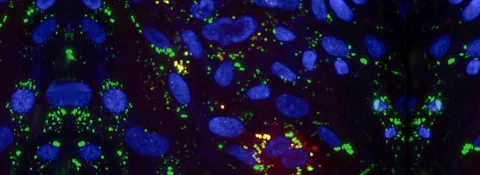
Stanford Report, February 18th, 2011 - by Sandip Ravindran
One bad apple is all it takes to spoil the barrel. And one misfolded protein may be all that's necessary to corrupt other proteins, forming large aggregations linked to several incurable neurodegenerative diseases such as Huntington's, Parkinson's and Alzheimer's.
Stanford biology Professor Ron Kopito has shown that the mutant, misfolded protein responsible for Huntington's disease can move from cell to cell, recruiting normal proteins and forming aggregations in each cell it visits.
Misfolded proteins can get into cells and form large aggregates by recruiting normal proteins. These aggregates are associated with neurodegenerative diseases. Stanford biology Professor Ron Kopito has found that the protein linked to Huntington's can spread from one cell to another. His research may explain how these diseases spread through our brains, an understanding that might lead to the development of drugs to target the misfolded proteins.
Knowing that this protein spends part of its time outside cells "opens up the possibility for therapeutics," he said. Kopito studies how such misfolded proteins get across a cell's membrane and into its cytoplasm, where they can interact with normal proteins. He is also investigating how these proteins move between neuronal cells.
The ability of these proteins to move from one cell to another could explain the way Huntington's disease spreads through the brain after starting in a specific region. Similar mechanisms may be involved in the progress of Parkinson's and Alzheimer's through the brain.
Kopito discussed his research Friday at the annual meeting of the American Association for the Advancement of Science in Washington, D.C.
Not all misfolded proteins are bad. The dogma used to be that all our proteins formed neat, well-folded structures, packed together in complexes with a large number of other proteins, Kopito said. But over the past 20 years, researchers have found that as much as 30 percent of our proteins never fold into stable structures. And even ordered proteins appear to have some disordered parts.
Disordered proteins are important for normal cellular functions. Unlike regular proteins, they interact with only one partner at a time. But they are much more dynamic, capable of several quick interactions with many different proteins. This makes them ideal for a lot of the standard communication that happens within a cell for its normal functioning, Kopito said.
But if some of our proteins are always disordered, how do our cells tell which proteins need to be properly folded, and which don't? "It's a big mystery," said Kopito, and one that he's studying. This question has implications for how people develop neurodegenerative diseases, all of which appear to be age-related.
Huntington's disease is caused by a specific mutated protein. But the body makes this mutant protein all a person's life, so why does that person get the disease in later adulthood? Kopito said it's because the body's protective mechanisms stop doing their job as we get older. He said his lab hopes to determine what these mechanisms are.
But it's clear what happens when these mechanisms stop working – misfolded proteins start recruiting normal versions of the same protein and form large aggregations. The presence of these aggregations in neurons has been closely linked with several neurodegenerative diseases.
Kopito found that the mutant protein associated with Huntington's disease can leave one cell and enter another one, stirring up trouble in each new cell as it progresses down the line. The spread of the misfolded protein may explain how Huntington's progresses through the brain.
This disease, like Parkinson's and Alzheimer's, starts in one area of the brain and spreads to the rest of it. This is also similar to the spread of prions, the self-replicating proteins implicated in mad cow disease and, in humans, Creutzfeldt-Jakob disease. As the misfolded protein reaches more parts of the brain, it could be responsible for the progressive worsening of these diseases.
Now that we know that these misfolded proteins spend part of their time outside of cells, traveling from one cell to another, new drugs could target them there, Kopito said. This could help prevent or at least block the progression of these diseases.
Kopito is currently working to figure out how misfolded proteins get past cell membranes into cells in the first place. It is only once in the cell's cytoplasm that these proteins can recruit others. So these studies could help find ways to keep these mischief-makers away from the normal proteins.
He is also collaborating with biology Professor Liqun Luo to track these proteins between cells in the well-mapped fruit fly nervous system. In the future, Kopito said he hopes to link his cell biology work to disease pathology in order to understand the role misfolded proteins play in human disease.

